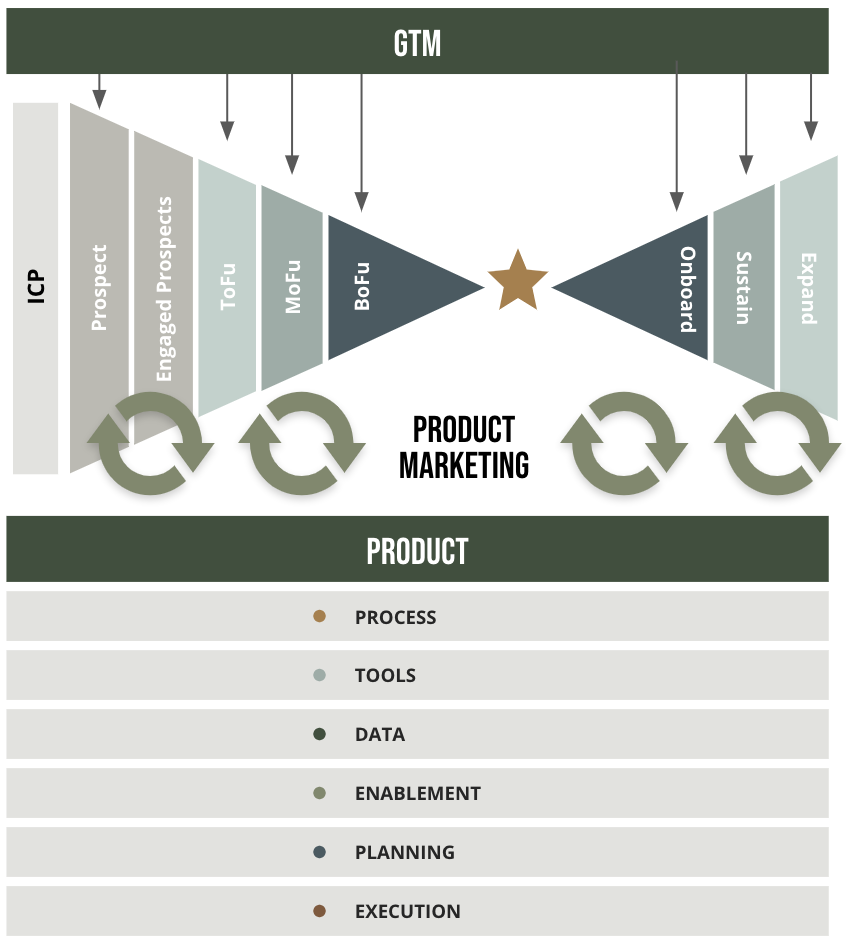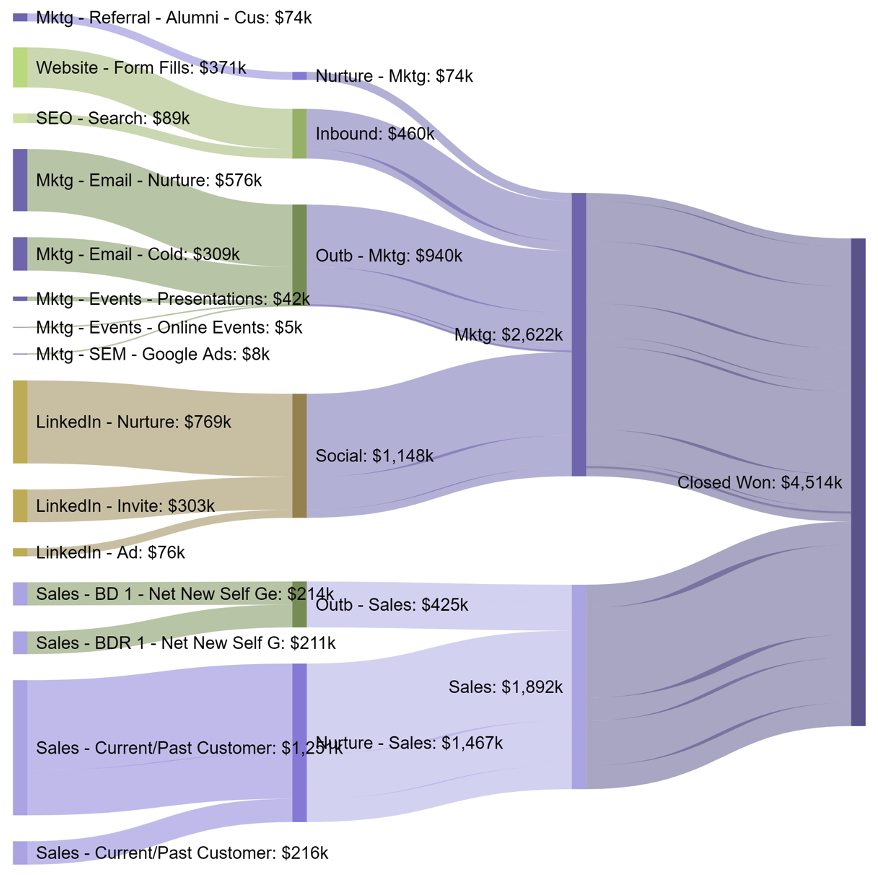
Want to know why most B2B companies are not making their numbers?
The tension in the Boardroom is high. It is yet another quarter where the CEO has the uncomfortable discussion with the Board about missing the quarter again. Let’s not divulge his name and call him “Ron” as this is a true story of one of our clients before we engaged with them. This time, the miss was by a large margin: 23%. Deep in his heart, Ron knew that the numbers the Board had given him were too aggressive, his pipeline was lead-starved, his conversion rates were too low, and his sales cycle did not have a high degree of predictability and was too long. The only thing that was predictable to Ron was the impossibility of making his number! And he had known this for a while.
Sound familiar?
Of course, if you know Blue Dots, you already know that the core issue with Ron and his team is misalignment, either along one of the four market-facing axes or internal factors.
How good are you at predicting your numbers?
Here is the question every CEO should be obsessed about: “When a new quarter starts, when do we know within 10% accuracy what bookings numbers we are going to hit for the quarter?” Of course, this is a challenging exercise because bookings are the results of so many variables and come from four different sources:
- Extension: booking growth comes from a price or volume increase.
- Expansion: booking growth comes from an acquisition or new geography.
- New initiative: bookings growth comes from selling a new project or a different product or service offering.
- New logo: bookings growth comes from first time buyers (could be a different business unit too).
Demystifying Rev Ops
Rev Ops is one of the most overlooked and misunderstood roles in most B2B organizations. So, let’s start by defining it. I am not talking about “Sales Ops” where someone comes in and administers Salesforce or makes sure all the mandatory fields are enforced or that the stages of the funnel are well-defined. I’m not even talking about the person who creates the sales compensation plans and territories. I am talking about a profound new way to think about how the entire company organizes itself for success.
One way to think about it, is the team in charge of GTM (go to market) Operations. The role is to optimize the entire customer journey from start to finish. It addresses the healthy tensions across finance and all GTM departments: Product Marketing, Sales, Marketing, Customer Success, Support and IT. This is strategic. The head of Rev Ops keeps everyone honest and for that reason does not report to Sales or Marketing. Remember, there is a reason Quality Control does not report into manufacturing. Same here. Ideally, the head of Rev Ops reports to the COO. If there is no COO, reporting to the CEO is the second-best option. The next option, but in most cases not ideal, is to report to the CFO, assuming that the CFO is not just focused on financials and numbers, but on processes, orchestration, and team alignment as well. Note that these CFOs tend to be rare!
The head of Rev Ops makes sure that ALL facets of the customer journey are covered and correctly managed by various groups. Rev Ops is ensuring that processes, systems, data and reporting reflect the precision segmentation, ICP and shows the contribution of messaging, content, and various lead gen sources. The Rev Ops organization tracks progress of the funnel and identifies opportunities for optimization. It is responsible for defining, integrating, and optimizing the tech stack including driving adoption. It often runs the productivity analysis (with finance) and territory planning. It engages with product marketing to gather all customer and prospect requests, normalize them, work the FP&A (financial planning and analysis) team to assign a weighted ARR contribution and review them during regular product planning review meetings.
The support and connective tissue of all these important steps is the job of the head of Rev Ops. That support is delivered through processes, tools, data (only measure and track data that is actionable and informs a decision), enablement (skills, tech stack, and competitive/market intel), planning (capacity planning, compensation strategy, territory alignment, etc.) and finally execution. Domestique, a Colorado-based consulting firm focused on Rev Ops, has a good illustration on how the full customer journey and Rev Ops intimately integrate:

The Head of Rev Ops is the conductor of the orchestra. Again, it’s the “connective tissue” that makes all various sections (string, winds, percussion, choir, soloist, …) play together in a harmonious way and off the same music sheet. Imagine if the violins, cellos, flutes, trumpets, percussions, etc. were playing each on their own? I don’t think you would buy an $80 ticket to listen to that orchestra! Keeping divisions and departments siloed off and letting political games be played is the root cause for not making the numbers in the vast majority of the cases we see at Blue Dots. Reinforcing silos with silo Ops (Marketing Ops, Sales Ops, Data Ops, etc.) creates opacity in understanding the buyer journey (and opportunities to improve it) as well as creates genuine disruption for the buyer. Rev Ops is all about silo breaking. It prevents information hoarding, lack of collaboration, misunderstood definitions, misplaced internal competition and team-based identity.
Rev Ops brings alignment and harmony to successfully drive revenue growth. No wonder there is an acute shortage of experienced Rev Ops managers. They are indeed in very high demand and hard to find. There are currently 20,193 open positions for them on LinkedIn. In the end, the head of Rev Ops is in charge of optimization and efficiency across the entire customer journey.
So, what is the right approach to successfully make the numbers?
The core issue is the “Predictive Growth Planning” gap. Numbers are not met because there is no good forward-looking forecast grounded in sound data, just a number typically pushed by the Board down the throat of the organization. Other typical issues are around high-cost, low-volume, low-quality leads, no data hygiene, and a half-baked tech stack that is too complex to manage and is not wired right, like a plane engine assembled by a bunch of car mechanics with no instructions.
Here is the problem in the B2B world: executives and board members believe that making the plan is all about understanding what persona is exposed to what marketing program, when and in which order. This is the challenge of attribution in ABM (account-based marketing). My view is that trying to solve the attribution problem is a lost cause and futile. That’s because in B2B, there are upwards of eleven touches before a target account converts to an opportunity. Yes, eleven! So, attribution cannot be determined and accurate because you simply do not know. It’s not about knowing who was the first or the last person, or anyone in between who was exposed to the product and involved in the buying process. However, you can say which channels, topics and campaigns were associated with more sales-accepted opportunities and more wins. That’s all you really know accurately, assuming, of course, that the right Rev Ops instrumentation is in place.
In the end, what matters is optimizing relative lead gen activity volumes (for example LinkedIn, SEO, SEM, inbound web, referrals, events, SDRs, etc.) to revenue outcomes. If this is not done correctly, then there are no early warnings if a particular lead gen program is below the expected outcome, and thus corrective action only comes once the bottom-up sales forecast starts going soft, which is often weeks or months later. Also, the budget cannot be optimized against outcomes for the most effective campaigns, i.e. to generate $X revenue, how much should we invest, and in which lead gen program? Note that initially, the best way to get started is to have a simple first-touch (within a reasonable timeframe) revenue allocation model. For more sophisticated companies, you can choose different revenue allocation models (can be evenly split, or a more sophisticated model based on the decision-making power of each person or on the cost to generate the lead based on the type of activity, etc.)
Growth must be architected, not just planned and certainly not merely hoped for. This is how forecasts are met within 10% accuracy. The forecast is really the output of all the various building blocks. A new approach must be a forward-looking, self-correcting process that does not rely on volumes of old meaningless data, especially if it is poorly maintained or comes with bad hygiene. It must be built on using an “Indirect Multivariable Adaptive Control” approach to plan, launch, measure and optimize bookings generation. It comes from control theory based on a “reference model.” It’s the exact opposite to what the vast majority of B2B companies do. They look backwards and use ubiquitous forecasting and analytics tools that require lots of accurate prior data for predictions that essentially are extrapolations of past trends. This is expensive, complex, time-consuming and does not work!
This new approach is like launching a rocket to the moon. It all starts by launching and shooting toward the moon (this is the reference model) and self-correcting frequently until the target is hit. We believe that this is much better than laboriously calculating a trajectory, forecasting the weather at launch time, predicting the movements of the earth and the moon and pre-programming the entire flight plan. If something is off, then the entire mission fails. On top of that, this renegade approach assumes that the business has all the right data and that it’s available and easily accessible. Right!
This new alignment delivers accuracy based on an integrated model with optimal revenue and budget forecast built on variables that are dynamically adjusted to fit different scenarios. The model is called GOALS (for growth optimization and acceleration system). It was invented by Johannes Hoech, who is a German-born, graduate from UC Berkeley in Naval Architecture and holds an MBA from MIT, is ex-McKinsey and a former COO at frogdesign and WhiteHat Security. Johannes is the founder and CEO of Premonio. The model is created in a couple of hours, not days or weeks, and then is recalibrated against actual data as it comes in monthly. All is reconciled on a dashboard with optimized budget and auto-generated KPIs and board-ready presentation slides. This way, the CEO sees what’s going on and is really in the driver’s seat. It avoids the situation where the CEO is the victim of sales not meeting the numbers with endless finger pointing including marketing that can’t produce good leads, or bad messaging, wrong segmentation, poor content, tools that are not working or missing product features and of course the usual one: lack of resources or time. Now CEOs can set goals and KPIs, vs. analytics that are cooked up to tell them, too late, whether their strategy is working or not. It creates board & exec alignment around a set of common goals across Sales, Marketing, Product Marketing, CS, and Rev Ops; as opposed to just managing the salesforce. It drives accountability across the entire organization and forces the implementation of good processes and data hygiene.
The output of the new approach is the revenue attained by lead gen program and the input are the funding expenditure: time, budget and manpower. Here is an example provided by Premonio (based on first-touch attribution) showing targeted new revenue on the right, and the contributory lead sources on the left, the thickness of each branch indicating that lead source’s share of the to be attained revenue:

In summary
CEOs must focus enough on GTM as a unified engine of growth and understand how the engine really works. This is how they can take control of quarterly booking generation using a forward-looking self-correcting approach with a strong Rev Ops team and the right tools. It’s all about internal alignment. It’s the only way to meet the right sensible growth plan. With such a disciplined approach, now the CEO will know, early in the quarter, the booking numbers with 10% accuracy.
If you need more information or would like to have a conversation with us on this critical topic, please contact me directly at [email protected].
Special thanks to our Project Partner, Joelle Kaufman, for giving some valuable input to this blog and the constructive conversations we had on the fascinating topic of attribution.